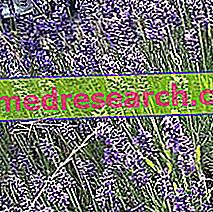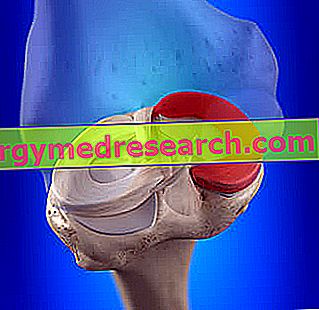
Scientific name
Lavandula vera, sin. L. officinalis, L. angustifolia ; Lavandula spica L., sin. L. latifolia L.
Family
Labiatae
Origin
Mediterranean region
Used Parts
Drug given by flowering tops
Chemical constituents
- Essential oil, whose main components are linalool, linalyl acetate, cineol and camphor. It should be emphasized that the composition of the essential oil may vary depending on the area in which the plant grows.
- Tannins .
- Hydroxycoumarins, among which we find umbelliferone.
- Caffeic acid and its derivatives.
Lavender in Herbal Medicine: Lavender Properties
Lavender flowers are used for their modestly sedative, but in particular antispasmodic properties, on the smooth muscles of the digestive tract and the bronchial tree.
The essential oil of lavender is used exclusively externally: obtained by distillation of flowers, and rich in esters, it has excellent anti-inflammatory properties; that obtained from Lavandula spica is rich in alcohols and oxides, has a good antimicrobial and balsamic activity and is well tolerated also by the respiratory mucosa.
Biological activity
Numerous activities are attributed to lavender: sedative, antispasmodic, anti-inflammatory, antimicrobial and even cholesterol-lowering. More precisely, all these properties are attributable to the essential oil extracted from the plant.
Some studies have shown that the anti-inflammatory action of the essential oil of lavender may derive from the interference of some of its components with the activity of phospholipase C. Moreover, the same study showed that the aforementioned essential oil is able to exercise a antinociceptive action very similar to that exerted by tramadol (an opioid analgesic), thereby also reducing pain.
Another study, however, showed that the essential oil of lavender is able to reduce the inflammatory component that characterizes the allergic reactions, through the inhibition of the degranulation of the mastocytes, therefore, inhibiting the release of histamine.
The antimicrobial properties of the essential oil, on the other hand, have been highlighted by several studies, which have shown that several of its components can be used as potentially effective bactericides against methicillin-resistant Staphylococcus aureus strains and vancomycin-resistant Enterococcus faecium strains. Furthermore, the essential oil of lavender - in particular, the linalool it contains - has also been shown to possess acaricidal properties, as well as having fungicidal properties in vitro.
Thanks to the antimicrobial action, the essential oil of lavender is often used externally to treat skin diseases, such as acne, rosacea or eczema, and to reduce irritation and redness (uses, however, not officially approved).
Some research has also highlighted the potential cholesterol-lowering properties of lavender essential oil. Properties that appear to be exercised through the inhibition of the hepatic enzyme hydroxymethylglutaryl-CoA reductase (or HMG-CoA), one of the enzymes involved in the synthesis of cholesterol. More in detail, it seems that this inhibition is due to the limonene and perillil alcohol contained within the same essential oil.
Furthermore, the potential anti-tumor properties of perillil alcohol are also being investigated.
As for the activity of lavender essential oil at gastrointestinal level - in addition to exerting an antispastic action - it is also endowed with carminative properties which, therefore, make it a useful remedy for combating flatulence and colic.
The sedative activity carried out by lavender essential oil, on the other hand, seems to be carried out through a mechanism similar to that performed by nitrazepam; therefore, the calming action is exercised directly at the central level.
Finally, lavender oil has proven effective, when used externally, in counteracting small circulatory disorders, so that its use has been officially approved for this particular therapeutic application.
Other approved uses are the treatment of restlessness and insomnia and the treatment of digestive disorders.
Lavender against restlessness and insomnia
As mentioned above, lavender essential oil can be used both internally and externally (aromatherapy) to counteract the restlessness, agitation and insomnia associated with them.
Generally, it is recommended to take 2-4 drops of essential oil a day, properly diluted. However, on the market there are numerous preparations containing lavender essential oil; therefore, for taking the product it is recommended to follow the instructions on the label, on the packaging or on the illustrative leaflet of the preparation you want to use.
Lavender against digestive disorders
By virtue of the carminative and antispasmodic properties exerted towards the gastrointestinal tract, lavender can be used for the treatment of small digestive disorders, flatulence and colic.
Also in this case, the recommended dose of essential oil to be taken is 2-4 drops per day, after dilution. Also in this case, it is good to follow the instructions provided by the manufacturer and indicated on the packaging, on the label or on the illustrative leaflet of the preparation you intend to use.
Lavender to combat circulatory disorders
Externally used essential lavender oil has been shown to be effective in treating some circulatory disorders. For this reason, it is not uncommon to be used in a particular type of thermal treatment called balneotherapy.
In this particular form of thermal cure, the essential oil of lavender is added to the thermal water (usually with a temperature of around 38 °) in which the patient must then immerse himself.
Popular Medicine and Homeopathy
The uses of lavender in folk medicine are many. In fact, this plant used internally is used as a remedy for bronchial asthma, cramps and headaches.
Externally, however, lavender is used in folk medicine as a remedy for rheumatism, exhaustion and tension, and to promote wound healing.
Lavender is also used in homeopathy with indications for the treatment of inflammations of the respiratory tract (such as laryngitis and pharyngitis), insomnia, agitation and as a remedy against insect bites, such as wasps and bees.
Side effects
Following the external use of lavender essential oil, side effects can occur on the skin, such as irritation, dermatitis and phototoxicity.
When taken internally, however, lavender can cause gastrointestinal disorders and drowsiness.
In addition, some cases of prepubere gynecomastia have been reported following the use of lavender and tea tree oils ( Melaleucaalternifolia ).
In case of overdose, serious adverse reactions may occur, such as depression of the central nervous system, respiratory depression, headache, vomiting and convulsions, up to death.
Contraindications
Avoid taking in the event of hypersensitivity to one or more components of lavender.
Lavender intake is also contraindicated during pregnancy and lactation.
Pharmacological Interactions
Not known



